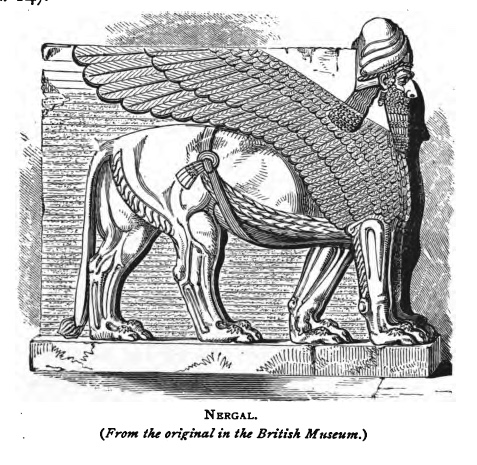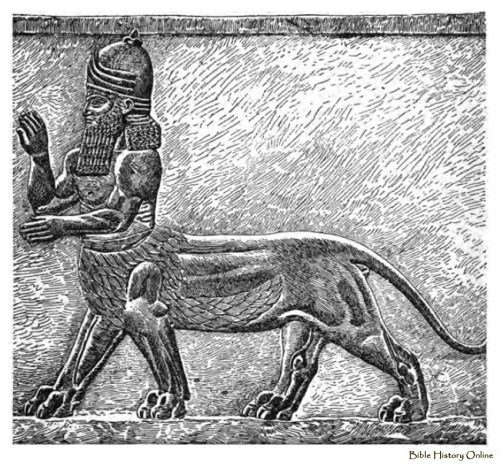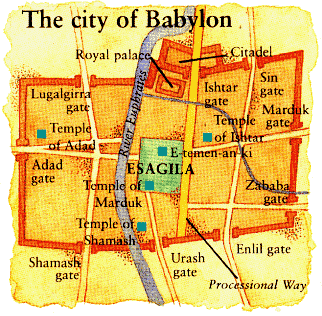The Knowledge of Fire and Prognostication Were Stolen From the Gods
“It was thus that “the divine storm-bird” of the ancient Accadian faith passed into the god Zu of the Semitic epoch.
“The divine storm-bird” was a ravenous bird of prey, of large size and sharp beak, who darted on its spoil and devoured the flesh. The Semitic Babylonians identified it with their Zu, partly because zu signified a “stormy wind,” partly because a species of vulture was called by the same name.
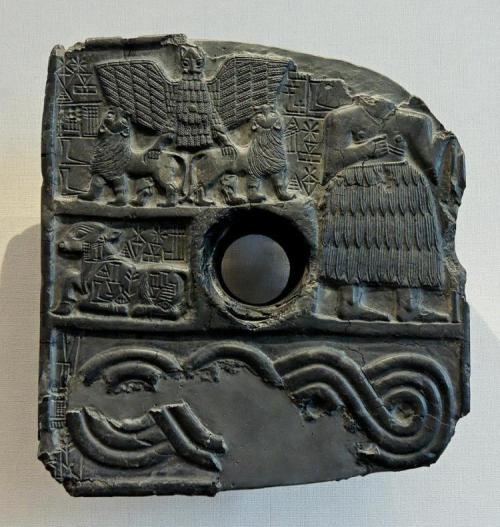
The Zu Bird dominates the top of this bas relief, while the head of the figure on the right is missing, common vandalism committed by grave robbers: defacing the heads and the eyes of idols crippled their efficacy.
But the conception of the tempest as a bird which rushes on its prey is common to many mythologies. In Aryan mythology the storm-cloud appears under the varying forms of the eagle, the woodpecker, and the robin redbreast, the sacred bird of Thor; while in Chinese folk-lore the storm-bird is “a bird which in flying obscures the sun and of whose quills are made water-tuns.”
The roc of the Arabian Nights, with its wings ten thousand fathoms in width, and its egg which it was a sin in Aladdin to wish to take from the place where it hung, is but an echo of the Chinese storm-bird. It is in the nest of the storm-bird that the tempest is brewed; it swoops upon the earth with the rush of his wings, and the lightning itself is but the gleam of his flight.
Even a poet of to-day instinctively speaks of the curlews as “dreary gleams about the moorland flying over Locksley Hall.”
“The divine storm-bird” was known as Lugal-banda, “the lusty king,” and was the patron deity of the city of Marad, near Sippara. He brought the lightning, the fire of heaven, from the gods to men, giving them at once the knowledge of fire and the power of reading the future in the flashes of the storm.
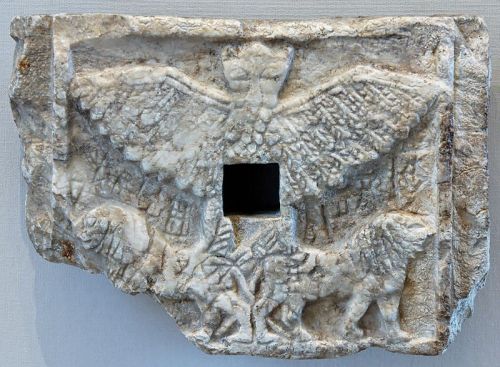
Zu or Anzu (from An ‘heaven’ and Zu ‘to know’ in Sumerian language), as a lion-headed eagle, ca. 2550–2500 BCE, Louvre.
Votive relief of Ur-Nanshe, king of Lagash, representing the bird-god Anzu (or Im-dugud) as a lion-headed eagle.
Alabaster, Early Dynastic III (2550–2500 BCE). Found in Telloh, ancient city of Girsu.
H. 21.6 cm (8 ½ in.), W. 15.1 cm (5 ¾ in.), D. 3.5 cm (1 ¼ in.)
http://bharatkalyan97.blogspot.com/2013/07/legend-of-anzu-which-stole-tablets-of.html
Like Prometheus, therefore, he was an outcast from the gods. He had stolen their treasures and secret wisdom, and had communicated them to mankind. In Babylonia, as in Greece, the divine benefactor of primitive humanity was doomed to suffer.
The knowledge and the artificial warmth man has gained are not the free gifts of the gods; they have been wrenched from them by guile; and though man has been allowed to retain them, his divine friend and benefactor is condemned to punishment.
The culture-god of totemistic Marad is thus a very different being from the culture-god of Eridu; both, indeed, are clad in animal form; but whereas the fish-god of Eridu is the willing and unhindered communicator of civilisation, whose successor, Merodach, becomes a god of light and healing, the bird-god of Marad is a pariah among his divine brethren, hunted out of heaven by the great gods, and wresting from them by craft man’s future knowledge of good and evil.
It was only in the later syncretic age, when these uglier facts of the earlier mythology were glossed over or forgotten, that the divine “bull” was described as “the offspring of the god Zu” (H.C. Rawlinson, The Cuneiform Inscriptions of Western Asia, 1886, iv. 123, 19).”
A.H. Sayce, Lectures on the Origin and Growth of Religion as Illustrated by the Religion of the Ancient Babylonians, 5th ed., London, 1898, pp. 293-5.

